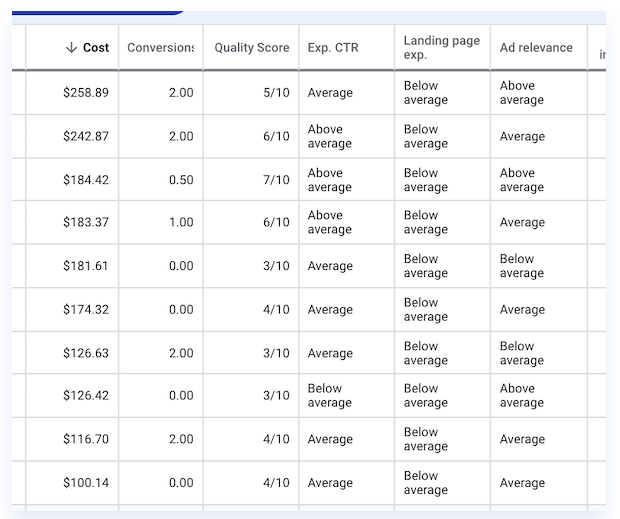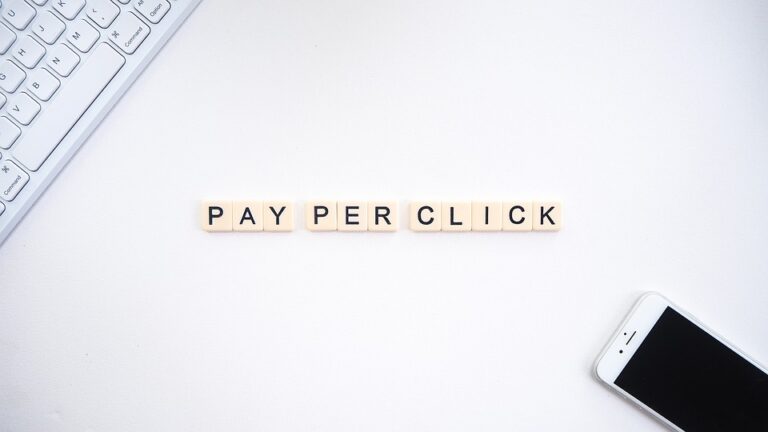You’re currently using Google Ads. But, your quality score is woefully low; I’m talking one’s, twos, and threes throughout your account. Despite your best intentions, what you’re doing is not working for your company. And, you’re not sure what you’re doing wrong or how you can improve your quality score. You’re stuck.

Does this sound familiar?
Fear not. In this article, I will go through the various components that make up a Google Ads quality score. Once I’ve laid down this groundwork, I will walk you through the steps you can take to improve it.
At Snowball Creations, we do paid ads for a living, So, I know all about Google Ads! Comment below if you have any questions!
Read on to learn how to improve your quality score on the Google Ads platform.
What is a Google Ads Quality Score?
First of all, what is a Google Ads quality score?
In your Google Ads account, you will see there are various columns to add to your dashboard. Each column describes a different component of your keyword success. You are either given a score of 1-10, or an ‘Average’ rating, depending on the column.
Essentially, each score tells you how good Google considers your ads to be for a specific keyword. It looks at everything involved in your campaign. And, it gives you an overall quality score based on all the scores across your columns. This is your Google Ads quality score.
A high-quality score of nine or ten is fantastic, although achieving a ten is quite rare. It means your getting everything right, everything is relevant, and your ads are likely to be very successful. You will probably also have a high ad rank on the search engine results pages.
In contrast, a low-quality score of one or two means that things are going wrong with your ads. And, as quality score affects ad rank, your ad will probably be further down in the ads section of the search.
While you can still get good results with low-quality scores, it is a lot harder. Therefore, it makes much more sense to take steps to boost your quality scores instead.
Since you’re reading this article, hopefully, you’ve already seen these columns and scores. If you’re not aware of them, you might need to switch to ‘Expert’ mode in the top right-hand corner of your dashboard.

On a side note, I’ve also created a YouTube video about this very topic. Feel free to check it out. Don’t forget to hit that subscribe button too so you don’t miss any new paid ads content from our channel.
What Columns Should You Have?
Your first step in getting a higher quality score is to add the right columns to your dashboard. These will give you a good picture of your ad campaign progress.
Here is a list of useful columns to add to your dashboard:
Quality Score – A cumulative assessment of your campaign and its success. Improving everything else i.e. everything in this list should improve the quality score.
Quality Score (hist.) – A view of your quality score’s historical performance. This is useful for determining whether previous efforts have worked.
Exp. CTR – Expected Click-Through Rate. The percentage of people (presented as “Average”, “Above Average”, or “Below Average”) Google expects to click through to your landing page after seeing your ad. This is based on ad relevance, landing page, etc.
Exp. CTR (hist.) – A historical view of your expected CTR.
Ad relevance – How relevant your ad is to user intent and a user’s search query. This is similar to CTR. It’s worth paying attention to both to get a fuller picture of your ad campaign’s success.
Ad relevance (hist.) – A historical view of Ad relevance.
Landing page exp. – Landing page experience. This means how relevant your landing pages are to user intent. Google looks closely at your landing page to decide this. It identifies things like meta descriptions, titles, keywords, and bounce rate.
Landing page exp. (hist.) – A historical view of landing page exp.

Arranging your columns in this specific order will make assessing your ad campaigns more straightforward. It works as a visual representation of the funnel users have to go through. Ordering your columns like this also makes it easier to pinpoint areas of improvement. Achieving solid results in all these columns will generate a high-quality score.
Why Does Quality Score Matter?
A quality score basically boils down to whether Google thinks a keyword in your ad, as well as your landing page, is good for a user.
Google is upfront with its Google Ads customers. It will make it clear if something is wrong with your campaign, whether it’s your ad copy or your landing page relevance. This is one of the things I like about the platform. After all, most others don’t offer the same level of honesty and guidance.
An Example of Why a Quality Score Matters
Let’s pretend you run an SEO agency. You have decided that you want your SEO agency ad to appear at the top of the ads on a search for the keyword ‘paid ads agency’. That keyword just doesn’t work. Someone is looking specifically for a paid ads service, which your company doesn’t provide.

Of course, you may have a strategy to entice these users to consider paid ads instead of SEO. But, this is not a strategy I would ever use or recommend. There are far better ways to spend your marketing budget and people out there looking for exactly what you offer!
Here’s why.
Google wants to give its search users what they’re looking for. It acts as a problem solver. This is the thing that makes Google a search engine leader. If they fail in this regard, people will ultimately stop using Google. Hence, Google wants to make sure users find what they’re after by showing them the most relevant ads.
That’s where quality scores come into play.
Google looks at all the elements of an ad campaign including ad copy, landing pages, and ad relevance to the search term. This is how it ensures that users are provided with the information they want. It then gives the advert a quality score so that they can actively improve their ads and appeal to the right audience.
How to Boost Google Ads Quality Score
Let’s get into the ‘How’ of improving your Google Ads quality score. There are two main areas that you should consider for this:
Google Ads Management
This is a huge topic. Ultimately, I’m referring to a lot of the top level ad management stuff.
Broad Match Keywords and Exact Match keywords
The actual keyword you are using. Ask yourself if it is a good keyword for users looking for your offering. There are different kinds of keywords too each that suit different purposes.

Broad match keywords can be, as the name suggests, too broad.
For example, if we, as an ad agency, used the keyword ‘agency’, that would be too broad to entice relevant clicks. We could show up for all kinds of agencies like project management agencies, creative agencies, or any other kind of agency you can think of. Unfortunately, these are completely irrelevant to what we do.
‘Paid ads agency’, on the other hand, is completely relevant to what we do. Therefore, using these exact match or phrase match keywords will help Google to display our ads in front of people that are more likely to click them.
This is a big way to improve everything throughout your campaigns. Which, of course, increases your quality score and can help lower your cost per click!
Using Negative Keywords
Another important aspect of Google Ads management for you to consider is your use of negative keywords. Negative keywords help your ads stay out of irrelevant searches that contain your keywords.
For example, if someone searches for ‘how do I start my own paid ads agency’, they’re probably not going to be looking to sign up with us any time soon. So, we don’t want to appear in this user’s search. To stop us from showing up in searches like this, we need to block some of these keywords. “how do I start my own”, in this instance, would be our negative (blocked) phrase.

‘Impressions’ is the number of times our ad shows up in a search. If these searchers don’t click on our ad for whatever reason, our Click Through Rate – and Expected Click Through Rate – will decrease. When we use negative keywords, our ad is placed in front of a better audience who are more likely to click on our ad. This will increase both our Click Through Rate and Expected Click Through Rate.
Combining better keywords with better negative keywords helps us in improving ad relevance to search terms. Ultimately, this will boost our Click Through Rate and improve our quality score.
Ad Quality
Another element of your ad campaign to look at to get a higher quality score is the ads themselves. To determine which elements, such as keywords, ad copy, landing pages, etc. perform the best, we generally create two unique ads. We then perform A/B testing on them.
When you’re A/B testing your ads, make sure you stay away from the ‘optimise automatically’ option. Instead, optimise your ads manually. You need to allow for a fair amount of time to analyse how your ads perform against each other. Often it can take weeks to be able to definitively pick a winner, the more data we have the quicker we can make an informed decision.
Reference the keyword you want to target in the main headline of your ad. Create several variations of this and pin it to number one in your Google Ads interface. This can help you improve ad relevance and, in turn, your CTR and quality score.
Landing Page Quality
The second main area to focus on to improve your quality score is your landing page quality.
Basic Landing Page Optimisation
This involves filling your landing page with relevant keywords you want to match. Back to our example of ‘paid ads agency’, you would put that keyword in the title, meta description, and throughout the landing page. This is one of the main things that Google looks for when placing your ad in a search.
Additionally, make sure that you are actually addressing the user’s query, need, or problem. If you have an unhelpful or poorly produced landing page, people will simply leave. The same goes for if there is no contact form or if it doesn’t look professional.

our aim is to make people stay on your page, and your website, for longer. You do this by fulfilling a need. Getting people involved in your site or engaged in your content will reduce your bounce rate. That is the rate at which people land on your page and quickly leave without visiting another page or actively browsing your site.
Use Ad Groups For Advanced Landing Page Optimisation
Finally, let’s look at a more advanced version of optimising landing pages and improving the landing page experience.
When you’ve got some data to analyse and work from, you can go on to create custom landing pages for each ad group. Each ad group would have its own URL. Your landing page for each ad group will be accurate to the keyword that belongs to that ad group.
You can go even more advanced still, you can more specifically tailor your landing page’s contents. For example, as an ad agency, we could match the keyword “eCommerce paid ads agency” to a landing page with content that was directly relevant to eCommerce. Case studies, for instance.
On the other hand, if someone was looking for a B2B lead generation agency, we would have a landing page with case studies more relevant to B2B.
I must stress though that this is not a day-one project for people just starting out. Get some traffic first and establish which keywords work. Once you have some data, you can use this method to take your campaigns to a new level.
Are You Ready to Boost Your Google Ads Quality Score?
To boost your Google Ads quality score, you really need to be looking at matching your keywords, ad copy, and landing pages with your target audience and their search queries. All these aspects must work together to optimise the user experience. Enticing clicks onto a relevant landing page with accurate keywords and the content will give you a higher quality score.
Here at Snowball Creations, we thrive on creating Google ads that give real, measurable results. If you need some help with snowballing your ad campaigns, drop us a message and we’ll get back to you asap.